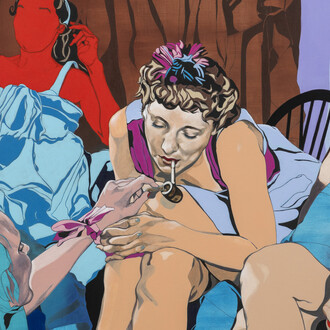The life of Jaume Amigó unfolds around the arts. Although his main dedication lies in painting, it is important to highlight his extensive and profound incursions into the world of printmaking, which have gradually merged into his pictorial practice through the use of techniques rooted in the language of engraving. His youthful years, linked to theatrical scenography, gave rise to a way of exhibiting that takes the form of installation, capable of engaging in dialogue with the viewer and overflowing beyond the limits of the canvas, like a river breaking its banks. Parallel to these installations, we must not overlook his sculptural explorations—often in ceramics, but also in iron and paper—which reveal his taste for a careful selection of materials: handmade papers and kaolin from the very lands he inhabits, works, and treads.
Amigó conceives the studio as a mobile space of creation, permeable to its surroundings. This perspective allows him to draw stimuli, materials, and techniques from the places where he settles, whether in Ifitry (Morocco), Osaka and Tokyo (Japan), or Amsterdam (The Netherlands). All these journeys are recorded in his notebooks, a vital testimony of his path. His return to the studio in l’Alzina de Ribelles, in La Noguera, has marked a new wave of forms, themes, and materials with which to channel his latest concerns—elements that, like passing mists and sea breezes, naturally integrate into his pictorial corpus.
His works often distill the essence of natural elements. Paintings and sculptures evoke clouds, water lilies, tunas, lichens, rice fields, or the tides he has witnessed in each of the places where he has established his studio. Frequently organized in thematic series, his works acquire meaning through cycles such as the one devoted to the path, strongly resonant of the poet Matsuo Bashō and his Narrow road to the interior (1694). Fascinated by the islands of the Balearics, Japan, and Indonesia, Amigó now leaves behind this “path” to focus on the concept of the island, the guiding thread of the present exhibition.
Islands like those drawn by the ebb tide along the coasts of Morocco, islands formed in fields around a tree or a rock, islands like the more than 17,500 of Indonesia or the 14,125 of Japan, which so profoundly inspire the artist. Islands that evoke the idea of isolation, so intrinsic to the creative process: intimacy and contemplation. Red islands emerging from a black-veiled background, ceramic islands which, although composed of separate units, when grouped together form a vast archipelago.















